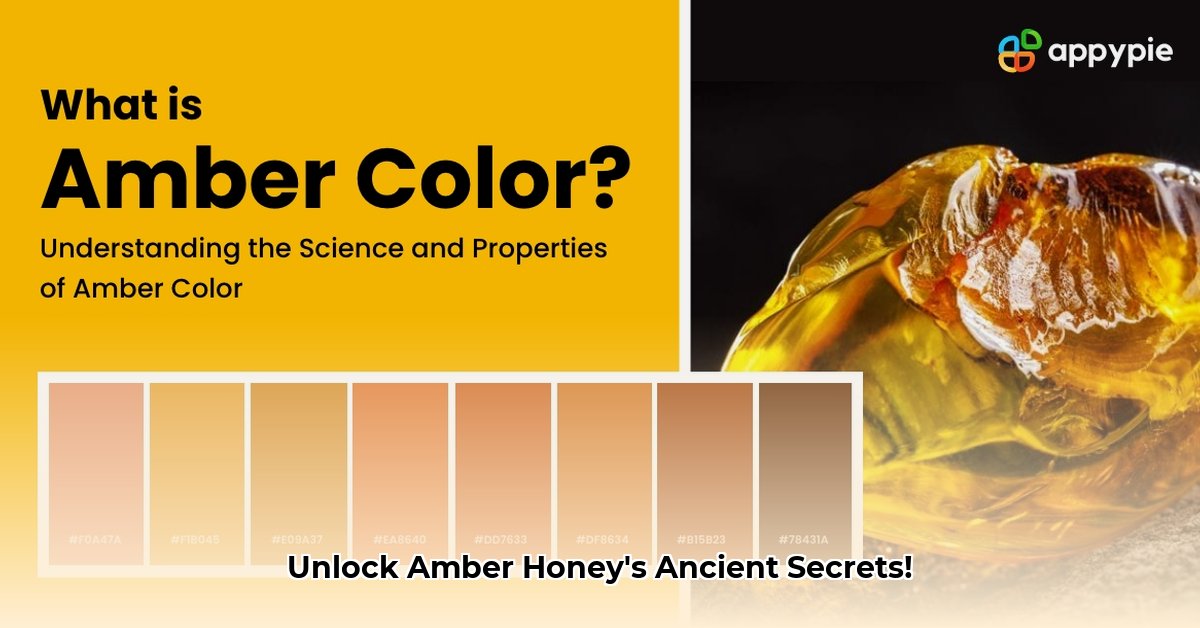Have you ever wondered about the differences between honey varieties or felt lost navigating honey grades? This guide reveals the secrets of amber honey – its distinctive flavor, potential health advantages, and how to choose the perfect jar. We’ll demystify honey grading, compare amber honey to other types, and equip you with the knowledge to interpret labels with confidence. Discover what to look for in high-quality amber honey, whether raw, organic, or pasteurized. We’ll even delve into the challenges faced by honey producers and retailers, providing a holistic perspective on this delicious and intriguing food. For a similar rich flavor, consider agave amber.
Amber Honey: Unveiling its Golden Allure and Nutritional Value
Embark on a journey into the captivating realm of amber honey, a unique variety celebrated for its exceptional flavor and potential health benefits. While lighter, clearer honeys dominate supermarket shelves, amber honey distinguishes itself with its depth of color and complex flavor profile. But what precisely sets it apart, and is it truly as remarkable as its rich hue implies? Let’s explore whether darker honey is indeed healthier.
Deciphering the Honey Grading System and the Pfund Scale
Honey grading is more nuanced than a simple A, B, and C classification. It’s a multifaceted evaluation, similar to wine judging, that focuses on several criteria. Official grading systems prioritize factors like clarity (transparency), aroma (scent), flavor (taste), and moisture content (water content). Often, lighter, clearer honeys, frequently graded as “Grade A,” are prominently displayed in supermarkets. However, the grading system doesn’t always capture the complete nutritional story.
The Pfund scale, a color chart ranging from water white to dark amber, is often referenced. While color is undoubtedly a key characteristic and influences consumer perception of quality, the Pfund scale doesn’t dictate the official honey grade. This is a critical distinction: color alone is not the ultimate determinant of a honey’s nutritional value.
Amber Honey: Exploring its Unique Characteristics and ORAC Value
Amber honey derives its name from its characteristic deep amber color, which distinguishes it from lighter-colored counterparts. This rich hue typically signifies a more intricate and intense flavor profile, often characterized by notes of caramel, molasses, or earthy undertones. Many believe that darker honeys, such as amber honey, are abundant in antioxidants – beneficial compounds that combat free radicals in the body. However, official honey grading systems do not directly assess antioxidant levels.
This leads to a common misconception: that darker honey automatically equates to greater health benefits. While some darker honeys, including amber honey, may exhibit higher concentrations of antioxidants (often quantified using the Oxygen Radical Absorbance Capacity, or ORAC, value), this is not a universal rule. The floral source from which the bees gathered nectar, along with processing methods, significantly influences the honey’s nutritional composition.
Consider apples: two apples may possess the same color, yet one may be sweeter or more nutritious depending on its growing conditions. The same principle applies to honey.
The Nutritional Truth About Amber Honey: Separating Fact from Fiction and Understanding Antioxidant Levels
A prevalent assumption is that darker honey inherently offers superior health advantages. While it’s conceivable that certain darker honeys, including amber honey, might contain elevated antioxidant levels, this should not be regarded as an absolute rule. The nectar source, the specific flowers visited by the bees, and the honey’s processing all exert considerable influence.
Current research endeavors to clarify the precise relationship between honey color, antioxidant content, and overall nutritional benefits. Existing evidence suggests a correlation, but it is not a straightforward, one-to-one relationship. Studies have indicated that darker honeys generally possess higher antioxidant activity due to the presence of phenolic compounds, but the specific types and concentrations of these compounds vary widely depending on the floral source.
Selecting the Perfect Amber Honey: A Guide to Reading Labels and Making Informed Choices
Choosing honey can be daunting, but here’s how to select a superb amber honey:
- Scrutinize the label: Look for details on the honey’s floral source (the specific flowers from which the nectar was collected), processing methods (raw, pasteurized, organic), and origin.
- Color as a clue, not a certainty: Amber honey’s deep color often hints at a more complex flavor, but don’t rely solely on color as your guide.
- Engage your senses: Ultimately, your sense of smell and taste are your most valuable tools! Inhale the aroma of the honey and sample a small amount to ensure you enjoy it.
Amber Honey: Addressing Challenges and Exploring Opportunities for Producers, Retailers, and the Honey Supply Chain
The existing honey grading system presents significant challenges for all stakeholders:
| Stakeholder | Challenges | Opportunities |
|---|---|---|
| Consumers | Difficulty interpreting grading systems and assessing nutritional value | Providing clearer information on honey types and their diverse benefits, including flavor profiles and potential health benefits. |
| Honey Producers | Communicating nutritional value effectively to consumers | Developing innovative grading systems that encompass nutritional data, sensory attributes, and sustainability practices. |
| Retailers/Supermarkets | Educating consumers about the diverse range of honeys available | Promoting premium honeys like amber honey based on their unique nutritional profiles, flavor characteristics, and origins. |
| Regulatory Bodies | Enhancing labels to include more comprehensive nutritional information | Funding research into honey’s health benefits and updating regulations accordingly to reflect scientific advancements. |
The future of honey grading demands enhanced transparency and empowered consumers. The public increasingly seeks clearer labels that accurately reflect nutritional and sensory qualities. A more comprehensive grading system that acknowledges the diverse attributes of honeys like amber honey is essential. This evolution could unlock new markets and foster greater consumer awareness.
- Plant-based Diet Colitis Remission: Success Stories - December 18, 2025
- Plant Based Diet Breast Cancer: Research-Based Benefits - December 16, 2025
- Plant-Based Diet Ulcerative Colitis Remission: Proven Benefits - December 15, 2025










